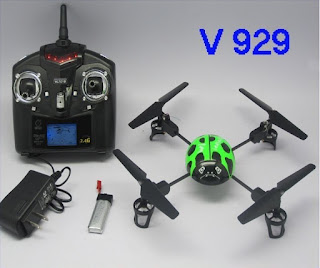Ev Yapımı Dört-Rotor
Önceki bir yazıda mini dört-rotoru nasıl yaptığımı anlatmıştım. Mini dört-rotorlar yapımı kolay olmasına rağmen küçük parçalar içerdiklerinden mekanik sıkışma, titreşimin giderilmesi ve malzeme seçimi gibi konularda zorluk çıkartabilirler. Bu yazımda yapması ve uçurması daha kolay olacak bir dört-rotor hakkında yazacağım. Amacım kullandığım malzemeleri ve teknikleri anlatmak. Yazıda bahsedeceğim dört-rotor aşağıdaki:
| Dört-rotorun genel görünüşü. Verici boyut anlaşılsın diye (1998'den kalma JR X3810 hala çok iyi; üzerinde Corona 2.4GHz modülü var). |
Kullandığım parçalar:
- Pervaneler: 8x4.5 inç düz ve ters dönen pervaneler
- Motorlar: Turnigy D2822-17, 1100KV
- Motor sürücü (hız kontrolü): Turnigy Multistar 20A
- Dengeleyici mikrobilgisayar: Crius MultiwiiSE 0.2 Benim kullandığımın yenisi kalmış.
- Batarya: Turnigy Nano-Tech 2.2Ah, 2s, 70C
- Alıcı: CR8D 4 kanallı alıcı
- Gövde: 3mm kontraplak ve aluminyum boru (Bilgisayar çizimleri aşağıda var).
Bu dört-rotoru yaparken önce yaklaşık boyuttan başladım. Sıklıkla kullanılan 8x4.5 pervaneler orta boy dört-rotorlarda iyi sonuç veriyor. Ülkemizde de bazı dükkanlarda hem düz hem de ters dönüşlüsünü bulmak mümkün. Bu nedenle onu seçtim. İki pervaneyi yan yana koyunca aralarında yaklaşık 2.5cm mesafe kalması iyi olur diye düşündüm; böylece diyagonalden kol uzunluğu ortaya çıktı. Bunlara karar verince gerisi uygun parçaların seçimi sadece.
Motorlar: 8.x4.5 pervane ile kullanılabilecek motorlar zaten aşağı yukarı belli. Bunlardan nispeten çok alacağımız için fiyatının da uygun olması lazım. Ben bu nedenle bu linkten Turnigy D2822-17 motorları aldım. Biraz internetten arayınca bunların 8x4.5 pervane için uygun olduklarını gördüm. Bu motorların fiyatı fena değil, tanesi 10 Dolar civarında. 4 yerine 5 tane almak iyi olur. Bir arıza çıkarsa yenisini sipariş edip beklemekten iyidir. Bana gelenlerden birisinde sürtünme biraz çok geldi, onu yedeğe ayırdım.
Hız kontrol: Hız kontrol da yaklaşık motorun azami akımını verebilecek türden ve ucuz olması lazım. Sıkca kullanılan Turnigy Plush markalar var, ama o gunlerde daha ucuza Turnigy'nin tam da çok rotorlular için çıkardığı hız kontrolörler gözüme çarptı. Turnigy Multistar. Bunların 20 amperlikleri işimizi görecektir ve fiyatı da 10 Dolar civarında. Aslında uçuş sırasında yaklaşık 750g ağırlık için sadece 2.5A-3A civarında akım çekiliyor, yani daha küçük sürücü alınabilir ama iki nedenle bunları seçtim: 1. Daha sonra gerekir belki (fiyat akıma göre çok değişmiyor), 2. Uçuş kontrolünce anlık olarak 2.5 Amperin çok üzerinde akımlara ihtiyaç duyulabilir. Yani yüksek kapasiteli hız kontrol daha kararlı uçuş anlamına da gelebilir. Geriye uçuş denetleyici bilgisayar, batarya ve ıvır zıvır kalıyor.
Hız kontrolörünün daha hızlı cevap vermesi için yazılımını değiştirmek mümkün. Bunun için Internette bazı ücretsiz özgür yazılımlar bulunuyor. Ben bunu yapmadan bir uçurmaya karar verdim. Sonuçlar iyi çıktı. Bu sürücülerin yazılımını değiştirmenize gerek yok. Başka hız kontrolörler gibi bunların gaz ayarını yapmaya da gerek yok, bunun bir yolu da yok zaten, aklınızda olsun.
Hız kontrolun bir de BEC çıkışı var. Bunlar 3A olarak yapılmış; oldukça yüksek bir değer. Birbirini yüklememesi için denetleyici bilgisayara hız kontrollardan sadece birinin BEC çıkışını bağlayın, diğerlerinin ya kablosunu kesin, ya da soketten çıkartarak (izole ederek) bir yere bantlayın. Yani dört hız kontrolun sadece birinin kırmızı kablosu denetleyici bilgisayara gidecek, diğer üçününkiler boşta kalacak. Kahverengi ve turuncu kabloları (0V ve sinyal kabloları) ise normal şekilde bağlayın...
Denetleyici bilgisayar: Bunun için de çeşitli seçenekler var piyasada. Yeni başlayan ve bilgisayarla arası olmayanlara bunun gibi bir şeyi tavsiye ederim: HobbyKing KK 2.0 Multi Rotor LCD Flight Control Board. Kutudan çıkartıp grafik LCD kullanarak kolayca ayarlayıp uçurmanız mümkün. Ben elimde bulunan biraz daha gelişmiş bir bilgisayarı kullandım: www.DealExtreme.com Crius Multiwii SE 1.0. Açık kaynak kodlu ve bir çok ayarını kendiniz yapabiliyorsunuz. Yeni başlayanlara zor, biraz bu konuyu bilenlere de büyük kolaylık.
Batarya: Tahmini çekilen akımın 10-12A olacağını düşünerek yaklaşık 8-10 dakika uçuş süresi ve (bolca) batarya rezervi ile birlikte Turnigy Nano-Tech 2.2Ah, 2s, 70C bataryalardan sipariş ettim. Bunlar 180g kadar ve 12 Dolar civarında, yani oldukça ucuz. İşini iyi görüyor. Şimdiye kadar 15-20 kez uçuş yaptım, herhangi bir terslik yok.
Gövde: Bu dört-rotoru hem herkesin yapabileceği şekilde basit ve ucuz, hem de çeşitli şekillerde imal edilebilir tasarlamak istedim. Gövdenin merkez kısmı 3mm kalınlıkta kontraplaktan, kollar ise et kalınlığı 1mm olan 20mmx10mm aluminyum profilden. Bunu bu sefer yeni öğrendiğim Soliworks ile yapmak istedim. Sonra da ahşap parçaları lazer kesicide kestim. Aluminyum profiller ise elde imal edildi. Tamamlandıktan sonra baktım da aslında 10x10mmlik profiller de kullanılabilirmiş. CAD dosyalarını buradan indirebilirsiniz. Önerdiğim yöntem tahta parçaları lazer ile kestirip aluminyum parçaları da elle hazırlamanız. CAD dosyalarının arasında "CAM_" ile başlayan dosyalar dört-rotorun üzerine takmak için hazırladığım kamera montaj kutusu. Onu da başka bir yazıda anlatacağım.
| CAD dosyasından görünüş. Perspektifi yanlış seçtiğim için biraz garip görünüyor. |
Nasıl uçuyor? Uçuş videosu aşağıda:
Aslında diğer pek çok dört-rotor videosu gibi sıkıcı, ama düzgün uçtuğunun da kanıtı...
Performans değerleri:
Toplam ağırlık (bataryalı): 710g
Boş ağırlık (bataryasız): 575g
Net kaldırma: 1445g
Azami güçte gerilim, çekilen akım, güç: 7.7V, 28A, 215W
Dengede uçuş sırasında (710g uçuş ağırlığı): 10.3A (motorlar ucuz ama oldukça verimli)
Toplam maliyet: Kumanda alıcı vericisi hariç yaklaşık 140 USD
| Boyut karşılaştırabilmeniz için Gaui 330XS ile birlikte fotografı. Neredeyse tıpatıp aynı (görünüşü o kadar güzel değil tabii). |


